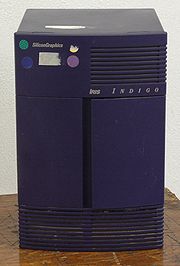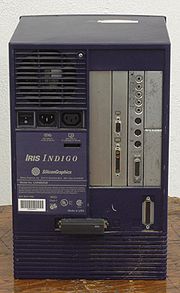
SGI Indigo
Encyclopedia


Workstation
A workstation is a high-end microcomputer designed for technical or scientific applications. Intended primarily to be used by one person at a time, they are commonly connected to a local area network and run multi-user operating systems...
computer
Computer
A computer is a programmable machine designed to sequentially and automatically carry out a sequence of arithmetic or logical operations. The particular sequence of operations can be changed readily, allowing the computer to solve more than one kind of problem...
s developed and manufactured by Silicon Graphics, Inc.
Silicon Graphics
Silicon Graphics, Inc. was a manufacturer of high-performance computing solutions, including computer hardware and software, founded in 1981 by Jim Clark...
(SGI). The first Indigo, code-named "Hollywood", was introduced on 22 July 1991. It was based on the IP12 processor board, which contained a 32-bit MIPS
MIPS Technologies
MIPS Technologies, Inc. , formerly MIPS Computer Systems, Inc., is most widely known for developing the MIPS architecture and a series of pioneering RISC chips. MIPS provides processor architectures and cores for digital home, networking and mobile applications.MIPS Computer Systems Inc. was...
R3000A microprocessor soldered on the board and proprietary memory slots supporting up to 96 MB of RAM. The later version (codename Blackjack) was based on the IP20 processor board, which had a removable processor module (PM1 or PM2) containing a 64-bit MIPS R4000
R4000
The R4000 is a microprocessor developed by MIPS Computer Systems that implemented the MIPS III instruction set architecture . Officially announced on 1 October 1991, it was one of the first 64-bit microprocessors and the first MIPS III implementation...
(100 MHz) or R4400 processor (100 MHz or 150 MHz) that implemented the MIPS-III instruction set. The IP20 used standard 72-pin SIMMs with parity, and had 12 SIMM slots for a total of 384 MB of RAM at maximum.
The Indigo was designed to run SGI's version of UNIX
Unix
Unix is a multitasking, multi-user computer operating system originally developed in 1969 by a group of AT&T employees at Bell Labs, including Ken Thompson, Dennis Ritchie, Brian Kernighan, Douglas McIlroy, and Joe Ossanna...
, known as IRIX
IRIX
IRIX is a computer operating system developed by Silicon Graphics, Inc. to run natively on their 32- and 64-bit MIPS architecture workstations and servers. It was based on UNIX System V with BSD extensions. IRIX was the first operating system to include the XFS file system.The last major version...
. The Indigos with R3000 processors were supported in IRIX through version 5.3 of that operating system
Operating system
An operating system is a set of programs that manage computer hardware resources and provide common services for application software. The operating system is the most important type of system software in a computer system...
, while Indigos equipped with an R4000 or R4400 processor can run IRIX 6.5 up to 6.5.22. Additionally, the free Unix-like
Unix-like
A Unix-like operating system is one that behaves in a manner similar to a Unix system, while not necessarily conforming to or being certified to any version of the Single UNIX Specification....
operating system NetBSD
NetBSD
NetBSD is a freely available open source version of the Berkeley Software Distribution Unix operating system. It was the second open source BSD descendant to be formally released, after 386BSD, and continues to be actively developed. The NetBSD project is primarily focused on high quality design,...
has support for both the IP12 and IP20 Indigos as part of the sgimips port.
The Indigo was considered one of the most capable graphics workstations of its era, and was essentially peerless in the realm of hardware-accelerated three-dimensional graphics rendering. For use as a graphics workstation, the Indigo was equipped with a two-dimensional framebuffer
Framebuffer
A framebuffer is a video output device that drives a video display from a memory buffer containing a complete frame of data.The information in the memory buffer typically consists of color values for every pixel on the screen...
or, for use as a 3d-graphics workstation, with the Elan
Elan Graphics
Elan Graphics is a computer graphics architecture for Silicon Graphics computer workstations. Elan Graphics was developed in 1991 and was available as a high-end graphics option on workstations released during the mid-1990s as part of the Express Graphics architectures family...
graphics subsystem including one to four Geometry Engines (GEs).
A Motorola 56000
Motorola 56000
The Motorola DSP56000 is a family of digital signal processor chips produced by Motorola Semiconductor starting in the 1980s and is still being produced in more advanced models in the 2000s. The 56k series was quite popular for a time in a number of computers, including the NeXT, Atari Falcon,...
DSP was used for Audio IO. Ethernet is supported onboard by the SEEQ 80c03 chipset coupled with the HPC (High-performance Peripheral Controller), which provides the DMA engine. The HPC interfaces primarily between the GIO
GIO
GIO is a computer bus standard developed by SGI and used in a variety of their products in the 1990s as their primary expansion system. GIO was similar in concept to competing standards such as NuBus or PCI, but saw little use outside SGI and severely limited the devices available on their...
bus and the Ethernet, SCSI (wd33c93 chipset), and the 56000 DSP. The GIO bus interface is implemented by the PIC (Processor Interface Controller) on IP12 and MC (Memory Controller) on IP20. Much of the hardware design can be traced back to the 4D/3x series, which shares the same memory controller
Memory controller
The memory controller is a digital circuit which manages the flow of data going to and from the main memory. It can be a separate chip or integrated into another chip, such as on the die of a microprocessor...
, Ethernet
Ethernet
Ethernet is a family of computer networking technologies for local area networks commercially introduced in 1980. Standardized in IEEE 802.3, Ethernet has largely replaced competing wired LAN technologies....
, SCSI
SCSI
Small Computer System Interface is a set of standards for physically connecting and transferring data between computers and peripheral devices. The SCSI standards define commands, protocols, and electrical and optical interfaces. SCSI is most commonly used for hard disks and tape drives, but it...
, and optionally DSP as the IP12 Indigo. Indeed, the 4D/30, 4D/35 and Indigo R3000 are all considered IP12 machines and run the same IRIX kernel. The Indigo R3000 is effectively a reduced cost 4D/35 without a VME bus. The PIC supports a VME expansion bus (used on the 4D/3x series) and GIO expansion slots (used on the Indigo). In all IP12, IP20, and IP22/IP24 (see SGI Indigo2) systems the HPC
HPC
HPC may refer to:* Handheld PC* Hasty Pudding cipher* Health Professions Council* Hemangiopericytoma* Hematopoietic progenitor cell* High-performance computing** Windows HPC Server 2008, an operating system for high-performance computing by Microsoft...
attaches to the GIO bus.
The Indigo was a visually pleasing design, based on a simple cube motif in indigo hue. Graphics and other peripheral expansions were accomplished via the GIO32
GIO
GIO is a computer bus standard developed by SGI and used in a variety of their products in the 1990s as their primary expansion system. GIO was similar in concept to competing standards such as NuBus or PCI, but saw little use outside SGI and severely limited the devices available on their...
expansion bus.
The Indigo was superseded generally by the SGI Indigo2 (and in the low-cost market segment by the SGI Indy
SGI Indy
The Indy, code-named "Guinness", is a low-end workstation introduced on 12 July 1993. Developed and manufactured by Silicon Graphics Incorporated , it was the result of their attempt to obtain a share of the low-end computer-aided design market, which was dominated at the time by other workstation...
), although Indigos remain useful among some specialties even into the 2000s.
External links
- http://www.NetBSD.org/Ports/sgimips/
- http://www.linux-mips.org/wiki/IP12
- http://www.megarat.com/indigo/
- http://www.obsolyte.com/sgi_indigo/
- http://www.irisindigo.com/

